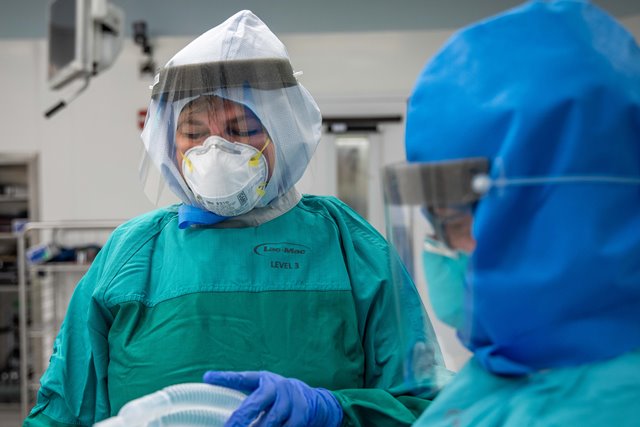
By Elaine Mitropoulos
In the face of a national PPE shortage, St. Joseph’s Healthcare Hamilton has developed a homegrown solution to reduce the risk of COVID-19 transmission – protective hoods sewn by volunteers, which are used throughout the hospital during high-risk aerosol generating procedures.
As St. Joseph’s Healthcare Hamilton gradually resumes health-care services, including surgeries, registered nurse Linda Schouwstra designed and fabricated protective hoods for her colleagues to wear during emergency intubations and surgical procedures.
A quilter in her spare time, Linda says she was prompted to make the protective hoods in early April, when the projected shipment of PPE the hospital normally uses was delayed owing to the pandemic.
“When we were running low on the product, someone asked, ‘do you think you can make something?’ I got up in the middle of the night – I couldn’t sleep – and made a template from some pumpkin fabric that I had in my sewing room,” Linda says. “It spiralled from there.”
From respiratory therapy to anesthesia, the protective hoods are used widely at St. Joe’s, and Linda has shared the pattern with other hospitals in the community.
Originally, Linda enlisted the sewing skills of her family and friends to make the first 300 hoods. She now has an army of St. Joe’s volunteers who are sewing hundreds of hoods in their homes, before they are sterilized in hospital.
Clyde Meldrum, a patient turned volunteer, is among the sewers. Normally, Clyde volunteers in the hospital’s outpatient pulmonary rehabilitation program. Over the course of the pandemic, however, Clyde – a former college professor – taught himself to sew with help from his wife.
“I lay out the hoods from the rough material, my wife cuts them, and I sew them,” says Clyde, who drives to the hospital from his home in Oakland, Ontario, to pick up kits containing the material. “It’s something we can do to help the hospital, the staff, and patients – we’re thrilled to be involved.”
The hoods are made from fabric used to wrap medical instrument sets. Once sewn, they are put through a sterilization process to mesh the fibres and make the hoods impervious.
“With the use of surgical drape material, the hoods have been designed to provide excellent protection for head and neck and are, as an added bonus, very affordable. These hoods are impermeable to water, are easy to don and doff, and even come in two sizes,” says Dr. Janet Farrell, chief of anesthesia at St. Joe’s.
“The hoods are now a standard part of our code blue protected anesthesiology equipment. With adversity comes invention!”
Elaine Mitropoulos works in Public Affairs at St. Joseph’s Healthcare Hamilton.

